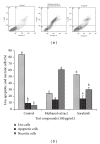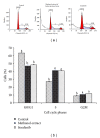Apoptotic and inhibitory effects on cell proliferation of hepatocellular carcinoma HepG2 cells by methanol leaf extract of Costus speciosus
- PMID: 24818148
- PMCID: PMC4000957
- DOI: 10.1155/2014/637098
Apoptotic and inhibitory effects on cell proliferation of hepatocellular carcinoma HepG2 cells by methanol leaf extract of Costus speciosus
Abstract
Costus speciosus is a medicinal plant commonly known as wild ginger distributed in South and Southeast Asian countries. Leaves of this plant are used for ayurvedic treatment regimes in malignancies and mental illness. Rhizome extract from the plant is used to treat malignancies, pneumonia, urinary disorders, jaundice, rheumatism, and diabetes. The goal of this study was to investigate the effects of methanol extract of leaves of C. speciosus on the growth of human hepatocellular carcinoma (HepG2) cells and understand possible mechanisms of its action. Viability of HepG2 cells were measured by MTS assay after 24 h and 48 h treatment with extracts of 1, 10, 50, 100, and 200 μg/mL concentrations. Cell cycle analysis and apoptosis were evaluated by flow cytometry and caspase-3 induction. HepG2 cells treated with 100 μg/mL methanol leaf extract for 24 h displayed a significant reduction in cell viability (P ≤ 0.05). The methanol extract perturbed cell cycle progression, modulated cell cycle and regulated, signal molecules were involved in induction of apoptosis in HepG2 cells. Our findings indicate that phytochemicals of leaves of C. speciosus shows potential for natural therapeutic product development for hepatocellular carcinoma. This is the first report to demonstrate in vitro anticancer activity of leaf extract of C. speciosus in relation to liver cancer.
Figures





Similar articles
-
Possible Anticancer Mechanisms of Some Costus speciosus Active Ingredients Concerning Drug Discovery.Curr Drug Discov Technol. 2016;13(3):123-143. doi: 10.2174/1570163813666160802154403. Curr Drug Discov Technol. 2016. PMID: 27515456 Free PMC article. Review.
-
Antioxidant and apoptotic effects of Callistemon lanceolatus leaves and their compounds against human cancer cells.Biomed Pharmacother. 2018 Oct;106:1195-1209. doi: 10.1016/j.biopha.2018.07.016. Epub 2018 Jul 19. Biomed Pharmacother. 2018. PMID: 30119188
-
Secondary Metabolites of Saussurea costus Leaf Extract Induce Apoptosis in Breast, Liver, and Colon Cancer Cells by Caspase-3-Dependent Intrinsic Pathway.Biomed Res Int. 2020 Jul 12;2020:1608942. doi: 10.1155/2020/1608942. eCollection 2020. Biomed Res Int. 2020. PMID: 32766303 Free PMC article.
-
Ethanol extract of Kalopanax septemlobus leaf induces caspase-dependent apoptosis associated with activation of AMPK in human hepatocellular carcinoma cells.Int J Oncol. 2016 Jan;48(1):261-70. doi: 10.3892/ijo.2015.3233. Epub 2015 Nov 5. Int J Oncol. 2016. PMID: 26549816
-
Exploring the anticancer potential of Costus speciosus: a comprehensive review.Braz J Biol. 2025 May 23;85:e294310. doi: 10.1590/1519-6984.294310. eCollection 2025. Braz J Biol. 2025. PMID: 40435094 Review.
Cited by
-
Pluronic-F-127-Passivated SnO2 Nanoparticles Derived by Using Polygonum cuspidatum Root Extract: Synthesis, Characterization, and Anticancer Properties.Plants (Basel). 2023 Apr 25;12(9):1760. doi: 10.3390/plants12091760. Plants (Basel). 2023. PMID: 37176818 Free PMC article.
-
The effect of chitooligosaccharides on oleic acid-induced lipid accumulation in HepG2 cells.Saudi Pharm J. 2016 May;24(3):292-8. doi: 10.1016/j.jsps.2016.04.023. Epub 2016 Apr 29. Saudi Pharm J. 2016. PMID: 27275117 Free PMC article.
-
Potential of Aucklandia Lappa Decne Ethanolic Extract to Trigger Apoptosis of Human T47D and Hela Cells.Asian Pac J Cancer Prev. 2018 Jul 27;19(7):1917-1925. doi: 10.22034/APJCP.2018.19.7.1917. Asian Pac J Cancer Prev. 2018. PMID: 30051673 Free PMC article.
-
Peptide of Trichinella spiralis Infective Larval Extract That Harnesses Growth of Human Hepatoma Cells.Front Cell Infect Microbiol. 2022 Apr 26;12:882608. doi: 10.3389/fcimb.2022.882608. eCollection 2022. Front Cell Infect Microbiol. 2022. PMID: 35558100 Free PMC article.
-
Possible Anticancer Mechanisms of Some Costus speciosus Active Ingredients Concerning Drug Discovery.Curr Drug Discov Technol. 2016;13(3):123-143. doi: 10.2174/1570163813666160802154403. Curr Drug Discov Technol. 2016. PMID: 27515456 Free PMC article. Review.
References
-
- Pang R, Tse E, Poon RTP. Molecular pathways in hepatocellular carcinoma. Cancer Letters. 2006;240(2):157–169. - PubMed
-
- Takayama T, Makuuchi M, Hirohashi S, et al. Early hepatocellular carcinoma as an entity with a high rate of surgical cure. Hepatology. 1998;28(5):1241–1246. - PubMed
-
- Poon RT, Fan ST. Resection prior to liver transplantation for hepatocellular carcinoma: a strategy of optimizing the role of resection and transplantation in cirrhotic patients with preserved liver function. Liver Transplantation. 2004;10:813–815. - PubMed
MeSH terms
Substances
LinkOut - more resources
Full Text Sources
Other Literature Sources
Medical
Research Materials

